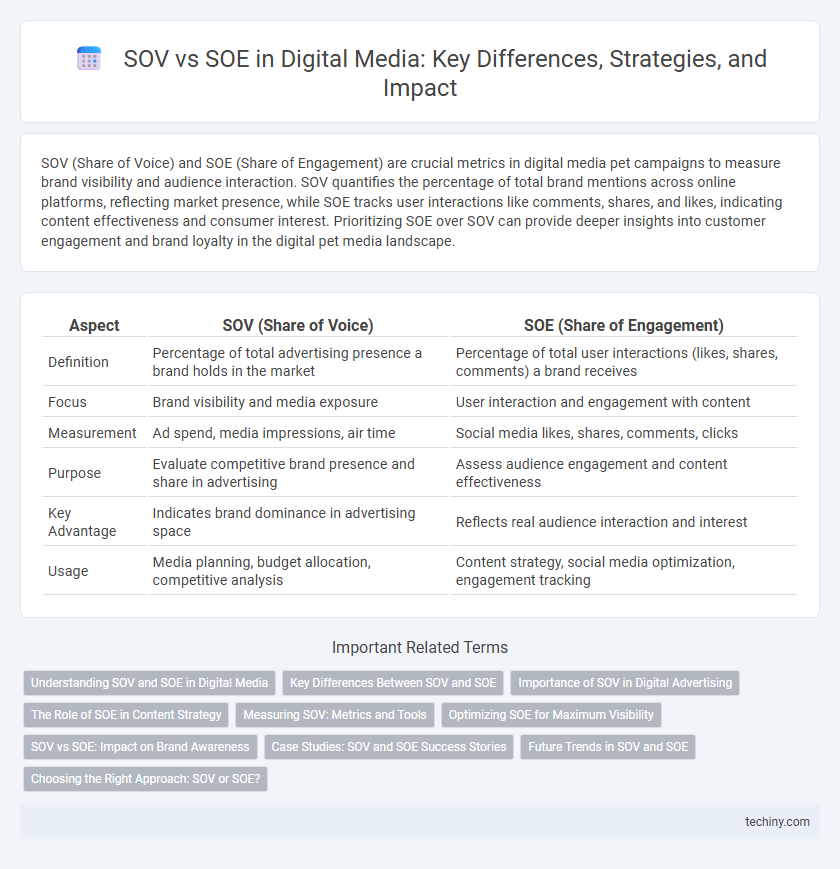SOV (Share of Voice) and SOE (Share of Engagement) are crucial metrics in digital media pet campaigns to measure brand visibility and audience interaction. SOV quantifies the percentage of total brand mentions across online platforms, reflecting market presence, while SOE tracks user interactions like comments, shares, and likes, indicating content effectiveness and consumer interest. Prioritizing SOE over SOV can provide deeper insights into customer engagement and brand loyalty in the digital pet media landscape.
Table of Comparison
| Aspect | SOV (Share of Voice) | SOE (Share of Engagement) |
|---|---|---|
| Definition | Percentage of total advertising presence a brand holds in the market | Percentage of total user interactions (likes, shares, comments) a brand receives |
| Focus | Brand visibility and media exposure | User interaction and engagement with content |
| Measurement | Ad spend, media impressions, air time | Social media likes, shares, comments, clicks |
| Purpose | Evaluate competitive brand presence and share in advertising | Assess audience engagement and content effectiveness |
| Key Advantage | Indicates brand dominance in advertising space | Reflects real audience interaction and interest |
| Usage | Media planning, budget allocation, competitive analysis | Content strategy, social media optimization, engagement tracking |
Understanding SOV and SOE in Digital Media
Share of Voice (SOV) in digital media measures a brand's advertising presence relative to competitors across platforms, reflecting market visibility and competitive strength. Share of Engagement (SOE) quantifies the interactions, such as likes, shares, and comments, that a brand receives, indicating audience connection and content effectiveness. Understanding SOV and SOE enables marketers to optimize campaign strategies by balancing visibility with active consumer engagement for improved digital performance.
Key Differences Between SOV and SOE
Share of Voice (SOV) measures a brand's advertising presence compared to competitors within a specific market, indicating competitive visibility and market dominance. Share of Engagement (SOE) evaluates user interaction across digital media platforms, reflecting the effectiveness of content in driving audience participation and brand loyalty. Key differences include SOV's focus on advertising spend and media impressions, while SOE prioritizes metrics like likes, shares, and comments to gauge consumer engagement levels.
Importance of SOV in Digital Advertising
Share of Voice (SOV) is a critical metric in digital advertising that measures a brand's visibility compared to competitors within a specific market or channel. Maintaining a higher SOV correlates strongly with increased market share and customer engagement, as it ensures dominant presence and consistent messaging across digital platforms. Brands investing in amplified SOV can effectively influence consumer behavior, drive brand awareness, and maximize the return on advertising expenditure in the competitive digital media landscape.
The Role of SOE in Content Strategy
SOE (Search Optimization for Engagement) plays a crucial role in digital media content strategy by enhancing user interaction and retention through targeted, relevant content that aligns with search intent. Unlike SOV (Share of Voice), which measures brand visibility, SOE focuses on optimizing content to increase dwell time, click-through rates, and social sharing, ultimately driving organic growth. Implementing SOE strategies involves analyzing audience behavior, keywords with high engagement potential, and designing content formats that encourage active participation and conversion.
Measuring SOV: Metrics and Tools
Measuring Share of Voice (SOV) involves analyzing brand mentions, social media engagement, and ad impressions compared to competitors using tools like Brandwatch, Hootsuite, and Google Analytics. Key metrics for SOV include total mentions, sentiment analysis, and share of advertising reach to assess brand visibility within the digital media landscape. Effective SOV measurement enables strategic adjustments in advertising spend and content targeting to maximize market presence, contrasting with Share of Engagement (SOE) which focuses purely on interaction rates.
Optimizing SOE for Maximum Visibility
Optimizing SOE (Share of Engagement) is crucial for maximizing visibility in digital media by leveraging content that drives deeper audience interaction and sustained attention. Focusing on high-quality, relevant content increases user retention, encouraging shares, comments, and likes that exponentially boost organic reach. Utilizing data analytics to tailor content strategy enhances SOE, creating a feedback loop that improves content performance and visibility across platforms.
SOV vs SOE: Impact on Brand Awareness
SOV (Share of Voice) directly influences brand awareness by determining a brand's visibility compared to competitors within digital media channels. Higher SOV typically results in greater consumer impressions and recall, contributing to stronger brand recognition and market presence. SOE (Share of Engagement) measures audience interaction, but without sufficient SOV, engagement alone may not significantly boost overall brand awareness.
Case Studies: SOV and SOE Success Stories
Case studies reveal that brands with a high Share of Voice (SOV) consistently outperform competitors in market growth and consumer engagement, highlighting the direct correlation between dominant digital presence and revenue uplift. Success stories from industries such as consumer electronics and travel demonstrate how sustained SOV leads to increased brand awareness and higher conversion rates across digital platforms. In contrast, Share of Engagement (SOE) case studies showcase how interactive content and community-driven strategies boost customer loyalty and amplify organic reach, driving long-term value especially in lifestyle and sports sectors.
Future Trends in SOV and SOE
Future trends in Share of Voice (SOV) and Share of Engagement (SOE) highlight the increasing integration of artificial intelligence for real-time audience analysis and content optimization. Brands are leveraging advanced analytics and machine learning algorithms to enhance SOV by targeting niche demographics while simultaneously boosting SOE through personalized, interactive digital experiences. The convergence of omnichannel marketing and data-driven strategies will revolutionize how companies measure and maximize their digital presence and consumer interaction metrics.
Choosing the Right Approach: SOV or SOE?
Selecting between Share of Voice (SOV) and Share of Engagement (SOE) hinges on campaign goals; SOV emphasizes the proportion of market advertising spend, ideal for brand awareness, while SOE prioritizes consumer interaction metrics, crucial for engagement-driven strategies. Marketers should analyze target audience behavior and platform specifics to determine if visibility or active participation aligns better with objectives. Integrating data analytics tools enhances decision-making by quantifying the impact of each approach on conversion rates and ROI.
SOV vs SOE Infographic

 techiny.com
techiny.com